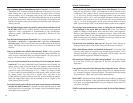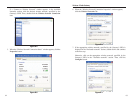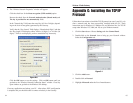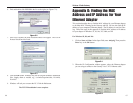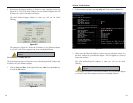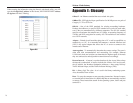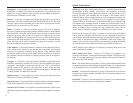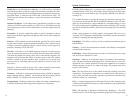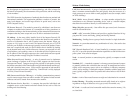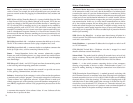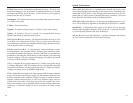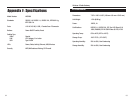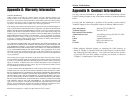
SPI (Stateful Packet Inspection) - A firewall technology that monitors the state
of the transaction so that it can verify that the destination of an inbound pack-
et matches the source of a previous outbound request. It examines not just the
headers of the packet, but also the contents, to determine more about the pack-
et than just its source and destination information. It is called "stateful" because
verifies that the stated destination computer has previously requested the cur-
rent communication. In this way, it verifies that all communications are initiat-
ed by the recipient computer and are taking place only with sources that are
known and trusted from previous interactions. In addition to being a more rig-
orous inspection, stateful packet inspection closes off ports until connection to
the specific port is requested. This allows an added layer of protection from the
threat of port scanning.
SSID (Service Set IDentifier) - A unique name shared among all points in a
wireless network. The SSID must be identical for each point in the wireless net-
work and is case-sensitive.
Static IP Address - A permanent IP address that is assigned to a node in an IP
or a TCP/IP network.
STP (Shielded Twisted Pair) - Telephone wire that is wrapped in a metal
sheath to eliminate external interference.
Subnet Mask - The method used for splitting IP networks into a series of sub-
groups, or subnets. The mask is a binary pattern that is matched up with the IP
address to turn part of the host ID address field into a field for subnets.
Switch - 1. A data switch connects computing devices to host computers,
allowing a large number of devices to share a limited number of ports. 2. A
device for making, breaking, or changing the connections in an electrical cir-
cuit.
TCP (Transmission Control Protocol) - A method (protocol) used along with
the IP (Internet Protocol) to send data in the form of message units (datagram)
between network devices over a LAN or WAN. While IP takes care of handling
the actual delivery of the data (routing), TCP takes care of keeping track of the
individual units of data (called packets) that a message is divided into for effi-
cient delivery over the network. TCP is known as a "connection oriented" pro-
tocol due to requiring the receiver of a packet to return an acknowledgment of
receipt to the sender of the packet resulting in transmission control.
79
Wireless-G Cable Gateway
Port - A pathway into and out of the computer or a network device such as a
switch or router. For example, the serial and parallel ports on a personal com-
puter are external sockets for plugging in communications lines, modems and
printers.
PPTP (Point-to-Point Tunneling Protocol) - A protocol which allows the Point
to Point Protocol (PPP) to be tunneled through an IP network. PPTP does not
specify any changes to the PPP protocol but rather describes a "tunneling serv-
ice" for carrying PPP (a tunneling service is any network service enabled by
tunneling protocols such as PPTP, L2F, L2TP, and IPSEC tunnel mode). One
example of a tunneling service is secure access from a remote small office net-
work to a headquarters corporate intranet via a Virtual Private Network (VPN)
that traverses the Internet. However, tunneling services are not restricted to cor-
porate environments and may also be used for personal (i.e., non-business)
applications.
RJ-11 (Registered Jack-11) - A telephone connector that holds up to six wires.
The RJ-11 the common connector used to plug a telephone into a wall.
RJ-45 (Registered Jack-45) - A connector similar to a telephone connector that
holds up to eight wires, used for connecting Ethernet devices.
Router - Protocol-dependent device that connects subnetworks together.
Routers are useful in breaking down a very large network into smaller subnet-
works; they introduce longer delays and typically have much lower throughput
rates than bridges.
RTS (Request To Send) - An RS-232 signal sent from the transmitting station
to the receiving station requesting permission to transmit.
Server - Any computer whose function in a network is to provide user access
to files, printing, communications, and other services.
Software - Instructions for the computer. A series of instructions that performs
a particular task is called a "program." The two major categories of software are
"system software" and "application software." System software is made up of
control programs such as the operating system and database management sys-
tem (DBMS). Application software is any program that processes data for the
user.
A common misconception is that software is data. It is not. Software tells the
hardware how to process the data.
78



